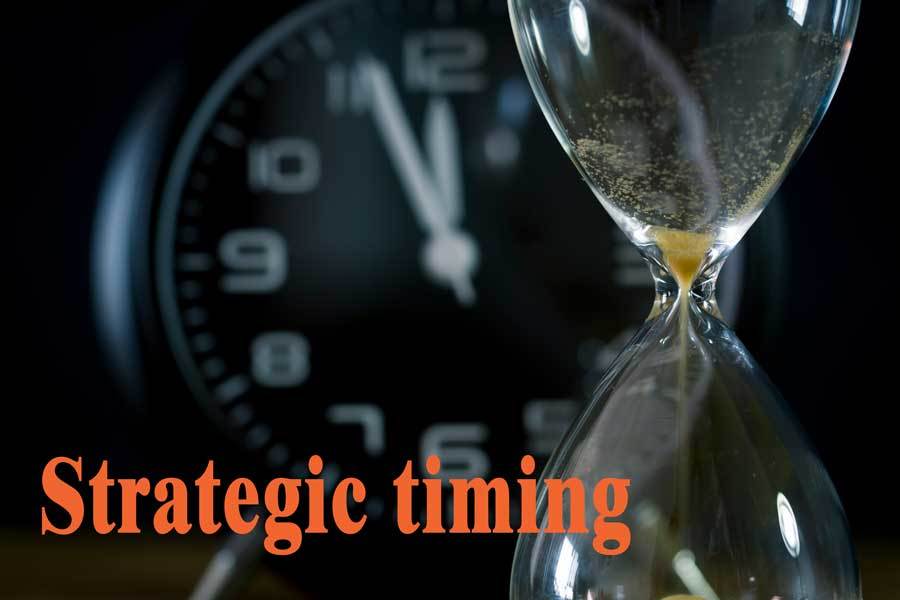- in Blog , Leadership by David Wilkinson
- |
- 1 comments
The four dilemmas of strategic timing

Having a good strategy is not enough. Like telling a good joke, strategy implementation success often hinges on timing. A new study has found that there are four primary dilemmas that leaders and managers need to face around strategic timing…
Contents
Developing and executing a strategy successfully takes more than just strategy formation and execution. A range of previous studies over the last 30 years have shown that getting the timing right when implementing a strategy is every bit as vital as its execution. The timing of the strategic move can make the difference between success and failure. Understanding not only when the optimal time to implement a strategy is, but also understanding how to pace strategy implementation are critical factors in successful strategy execution.
Not taking the time to involve relevant stakeholders, getting the sequencing wrong or failing to recognise the impact of external environmental issues, such as political, economic or technological change, for example, can have dire effects on the outcomes of a strategy. Additionally, strategic timing and pacing (implementing or pushing a strategy through too quickly or too slowly) can have dire consequences. At best, getting the timing and pacing of strategy execution wrong can have unintended consequences and, at worst, either render the strategy irrelevant or even bankrupt the organisation or make it irrelevant.
Poor strategic timing can also decrease strategic adoption, demotivate employees and even cause resignations and increase staff turnover, but just at the wrong time.
A new study – the four dilemmas
A new study by researchers from the Engineering Systems Division at the Technical University of Denmark has looked at the issue of strategic timing and found that there are four primary dilemmas facing leaders and managers trying to get the timing of their strategy right:
1. When to implement – the time horizon dilemma
2. Pacing and urgency – the urgency dilemma
3. Process – the process dilemma
4. Rhythm – the rhythm dilemma.
The issue here is that strategies are primarily about creating a desired future. The problem is that it is impossible to know everything about the future, what will happen and how other issues in the future will interact with our plans. The prime dilemma is what is known as a time horizon issue. How far into the future should we be looking? How accurate is our understanding of where we are now? Are we being ambitious enough or too ambitious? The need for realism falls against the need for ambition, creativity and innovation.
The base problem in the time horizon dilemma is how to balance today’s ‘realism’, which is based on our understanding of our current reality, technology, political and economic environment, with our creative desires of what might be in the future. The trouble being that realism can be both grounding and restricting, whereas ambition can be both visionary/motivating/farsighted and unrealistic/improbable/naïve.
All strategies have to work out how far they can be ambitious and not restrict themselves too much, whilst at the same time keeping things within the bounds of possibility and probability.
Understanding that this dilemma exists can help strategists manage this balance between ambition and current reality.
The urgency dilemma is based on the problem of both creating the space for:
· reflection
· thinking
· maturation
· embedding
· practice and skills development
· systems and processes to start to work together
and creating:
· movement
· change
· speed
· energy
· impetus
· necessity.
Understanding when to push and create urgency and when to hold back and allow time for things to become embedded and for evaluation and reflection requires that leaders and managers are closely in touch with the organisation and the strategy implementation process, as it is happening.
On the one hand, urgency can be motivating and energising, but, on the other, can lead to rash, ill-considered decision-making, a lack of attention to data and feedback and burnout. At the other end of the spectrum, suspending urgency can allow ideas and practices to become embedded and germinate and for issues to be dealt with. However, this can also stall progress, create frustration and reduce momentum.
Strategists that understand the urgency dilemma can ‘feel’ their way forward by staying in touch with how the strategy implementation is going and make evidenced decisions about when to push harder or when to let go.
To get the full research briefing and reference … Members please go to the library and search for “four dilemmas”.
Whilst there are many other issues to do with strategy implementation and execution, this examination of the dilemmas inherent in the timing of strategy execution is most useful. Understanding the dilemmas faced by those involved in strategy implementation and execution can help them to navigate those dilemmas. Being unaware of the four dilemmas of strategy timing can lead to all sorts of problems.



3loveless